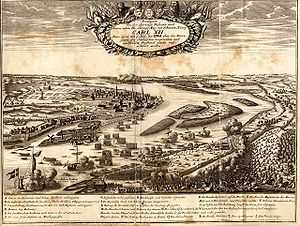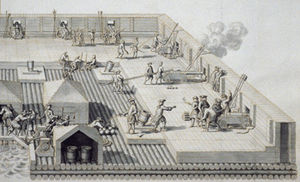- Crossing of the Düna
-
Crossing of the Düna Part of the Great Northern War 
Swedish Army crossing the DünaDate July 9, 1701 Location Riga, Livonia Result Decisive Swedish victory Belligerents  Sweden
Sweden Saxony
Saxony

Commanders and leaders Charles XII August II
Adam Heinrich von SteinauStrength 7,000 men Russian 10,000
Saxons 9,000
Total:
19,000Casualties and losses 100 KIA - 400 wounded 2,000 KIA The Crossing of the Düna on July 9, 1701 was a Swedish push into the Polish-Lithuanian Commonwealth after the Swedes' victory at the Narva in late 1700. The Swedish king Charles XII was in hot pursuit king Augustus II the Strong of Poland and Saxony, who was commanding Saxon and Russian troops. The battle turned out to be a great Swedish triumph, the crossing was easily made, and enemy troops were quickly broken and scattered by retreat.
The battle started on the morning of the 9th. The Saxon/Russian army numbered approximately 19,000 men, under the command of the Saxon Generalfeldmarschall Adam Heinrich von Steinau. In the first attack wave about 7,000 Swedes crossed the Düna (Daugava), supported by a number of heavily armed ships, which under cover of smoke had managed to sail up the river. The Swedes launched a surprise attack on the Polish and Saxon forces camped on the opposite bank of Düna (Daugava) in the Spilve meadows. As the smoke slowly cleared away, the Saxons become aware what was going on and immediately launched a counterattack. The Swedish force, under the personal command of the king, would not retreat. After a brief stalemate, the Swedes managed to form up and initiate a second attack. After two hours the battle was won. The Swedish army successfully crossed the river, and the Saxons were in retreat.
During the battle, small barges armed with cannons were used, thus combining land and sea forces as well as deception (smoke) to achieve a stunning victory, carefully planned and very well executed.
After the battle, Courland fell to Sweden, and Charles XII and his army marched into Bauska, where the army stayed until August 11.
In preparation for his attack on Riga, king Charles XII ordered the first bridge across the Daugava, which was made of anchored and interconnected by ropes boats. After the Swedish victory, the city was left with the structure. In 1705, the bridge, which had been lodged for the winter in Vējzaķsalas Bay, was washed away by the high spring waters. Later, the floating bridge was restored, but in 1710, it was destroyed again by the Russian army when it besieged Riga.[1]
Participants included Otto Arnold von Paykull.
References
Battles
- 1st Tönning
- Narva (1700)
- Düna
- Erastfer
- Hummelshof
- Kliszów
- Pułtusk
- Jēkabpils
- Nöteborg
- Poznań
- Narva (1704)
- Punitz
- Gemauerthof
- Warsaw
- Grodno
- Fraustadt
- Kalisz
- Holowczyn
- Malatitze
- Lesnaya
- Koniecpol
- Poltava
- Perevolochna
- Vyborg
- Pruth Campaign
- Helsingborg
- Gadebusch
- 2nd Tönning
- Bender
- Finland
- (Pälkäne
- Storkyro
- Gangut)
- Stralsund
- Dynekilen
- Fredriksten
- Carolean Death March
- Ösel
- Stäket
- Grengam
Categories:- Battles of the Great Northern War
- Conflicts in 1701
- 1701 in Europe
Wikimedia Foundation. 2010.

